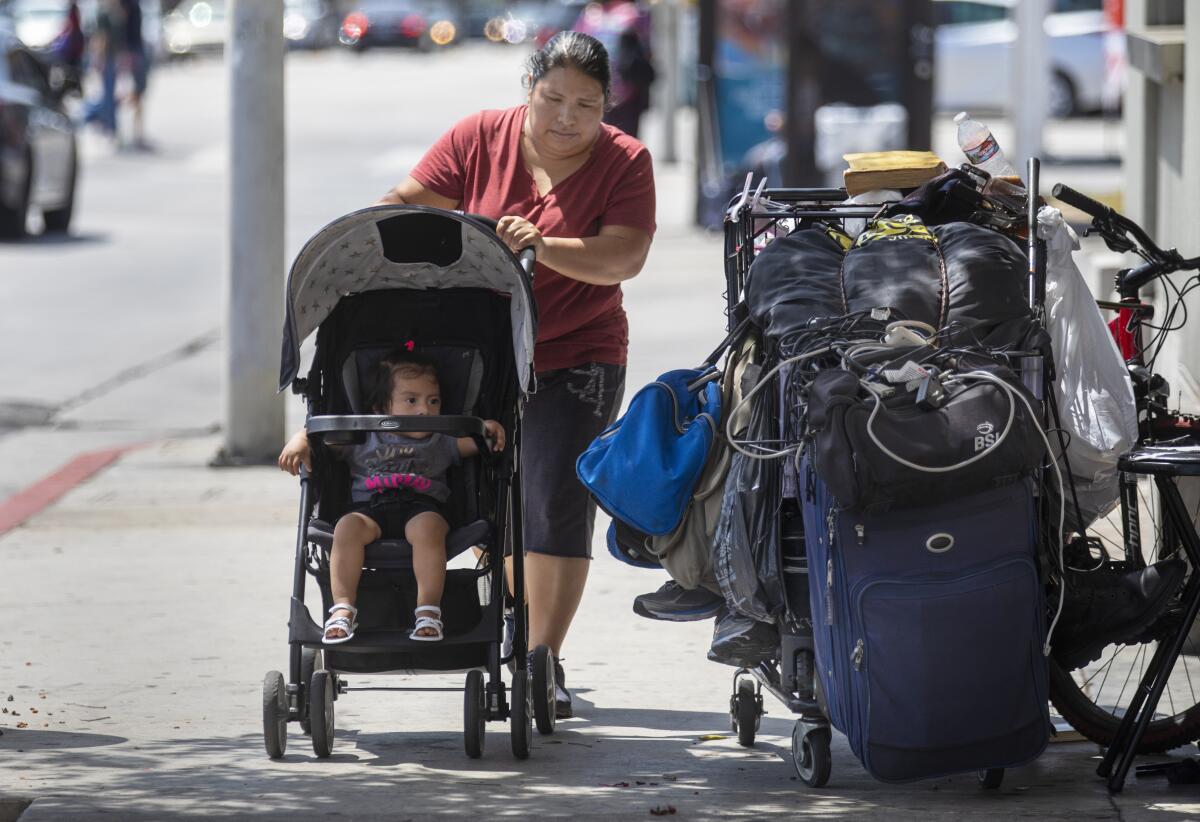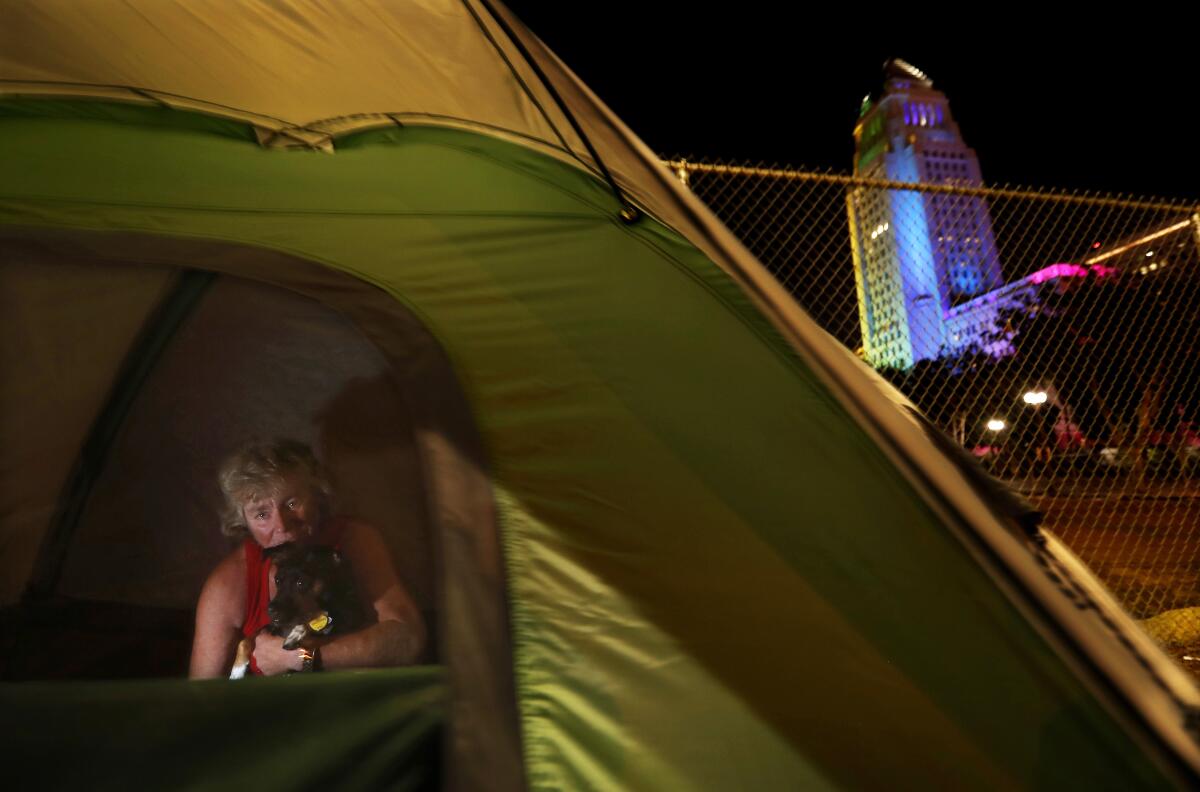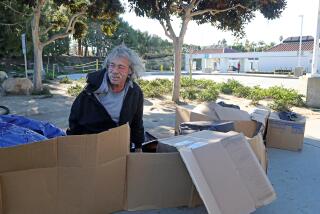L.A. is again considering limits on where homeless people can sleep — this time by schools and parks

- Share via
Los Angeles has long been locked in battles over where and how people can bed down on its streets and sidewalks — a debate that has played out for decades in City Hall, in the courts and on avenues lined with squalid tents and bedrolls.
The city has been brushed back in court by homeless advocates, who argue that it is cruel and useless to punish people if they have nowhere else to sleep. Last year, those advocates hailed a federal ruling against a Boise, Idaho, law that prohibited sleeping on the street, saying the ruling cemented their earlier victories in Los Angeles and set a crucial precedent across the western United States.
Now L.A. politicians are weighing a new set of rules that could bar people from sitting or sleeping on streets and sidewalks near schools, parks and day care centers, and in a range of other prohibited areas — an idea that has drawn fire from homeless advocates.

With tens of thousands of people bedding down on the streets — far more than the city can house in new homeless housing or shelters built to date — “You can’t do this and expect that you’ll have something that’s enforceable,” said attorney Carol Sobel.
The newly proposed restrictions, put forward by Councilman Mitch O’Farrell, would replace a blanket ban on sidewalk sleeping that has been on the books for decades, but which L.A. had agreed to pull back on enforcing at night after being sued by skid row residents.
Sobel, one of the attorneys who represented homeless people in the Jones vs. City of Los Angeles case, called the proposed rules “completely unworkable” and argued that it was ridiculous for city officials to frame their newly proposed restrictions as an effort to comply with the Boise ruling.
The Boise ruling “does not require you to put in all these restrictions,” Sobel said, arguing in a letter to council members that the proposed rules would make it almost impossible to sleep anywhere on skid row.
The disputed section of the Municipal Code — 41.18(d) — has been a rallying cry for neighborhood activists who argue that the Jones settlement has led to chaos and blight on city sidewalks. Mark Ryavec, president of the Venice Stakeholders Assn., said that the proposed rules failed to address the most important issue: homeless encampments in or abutting residential areas.
“What we’re dealing with here in Venice — and what is so difficult for residents — is these encampments literally being in their frontyard,” argued Ryavec, whose group has repeatedly sued the city over homelessness issues.
The proposed rules were unveiled at the council’s homelessness committee meeting Wednesday at City Hall, where Senior Assistant City Atty. Valerie Flores said that prohibiting people from sleeping near schools, parks, newly established shelters and in other specified areas would be legally defensible, even after the federal decision that tossed out rules against sleeping on public property in Boise.
In that case, a federal court ruled that “as long as there is no option of sleeping indoors, the government cannot criminalize indigent, homeless people for sleeping outdoors, on public property.”
But the court also opined that “even where shelter is unavailable, an ordinance prohibiting sitting, lying, or sleeping outside at particular times or in particular locations might well be constitutionally permissible.”
Flores argued that L.A.’s existing laws on sidewalk sleeping “would benefit from modernization, clarification and a better balance between the competing needs of persons using the public right-of-way.”
After meeting with Flores and other city staffers behind closed doors Wednesday, O’Farrell laid out the proposed rules: No sitting, lying down or sleeping within 500 feet of schools, parks or day care centers. No bedding down near homeless housing, shelters or other facilities to serve homeless people that have opened in recent years.
People would also be banned from bunking down on bicycle paths, in tunnels or on bridges designated as school routes, in public areas with signs barring trespassing or setting closing times for safety or maintenance purposes, and in crowded areas near big venues such as Staples Center.
And people sleeping on the streets would still have to stay away from entrances and driveways and leave enough room for wheelchair users to pass under the Americans With Disabilities Act.
O’Farrell said in a statement Thursday that “the reality is we have sensitive areas to consider and as city leaders we must strike the balance between the needs of those experiencing homelessness and keeping our public spaces safe and accessible.”
John Lee, who was recently elected to represent the northwestern San Fernando Valley in a council race that focused heavily on homelessness, said he was still reviewing the proposed rules but called them “a good step” toward protecting public safety and ensuring sidewalks are accessible.
“As I said during the campaign, we need to be compassionate to homeless people,” Lee said. “But we have to be compassionate to businesses and homeowners too.”
The proposed rules still have to be vetted by the full City Council and drafted by city lawyers before coming back to council members for approval. At the Wednesday meeting, council and committee member David Ryu said he was hearing the proposal for the first time. A spokesman for Mayor Eric Garcetti said Thursday that their office was reviewing the proposal.
Progressive activists said they were galled by the idea.
Such rules would “create containment zones like skid row all over the city,” putting homelessness out of sight without addressing the need, said Jed Parriott, a member of the Services Not Sweeps coalition. He and other activists had urged the city to repeal, rather than amend or replace, the existing ban on sidewalk sleeping.
David Busch, a longtime activist who is homeless in Venice, said the city was “looking at this problem backwards.”
“Instead of saying, ‘Where can people sleep?’ they continue to pass things telling us where we can’t sleep,” Busch said. “We can issue hundreds more tickets, tie up more courtrooms, more jails, more police time with homeless people … and the city can pay out millions more in civil rights lawsuits, or we can do what we need to do.”
Other Angelenos had argued against loosening the law on the books. In a letter to council members before Wednesday’s meeting, Venice resident Travis Binen said that with tens of thousands of people living on the streets, “the city needs to be able to legally move them instead of leaving them on the sidewalk to die or harm others.”
Ryavec, the Venice association president, said that it was premature to adjust the rules, arguing that the city should instead be working with Boise to reverse the “ridiculous decision” that was handed down by the 9th U.S. Circuit Court of Appeals. Attorneys representing Boise filed a petition Thursday asking the U.S. Supreme Court to review the federal ruling, arguing that the court decision would have “catastrophic” effects.
L.A. and other cities “are grappling with how to interpret and follow the decision,” which “raises more questions than it answers,” said Theane Evangelis, lead counsel for Boise.
Evangelis argued that the Boise ruling ties the hands of cities to deal with the harmful effects of encampments, including fires and disease. “It’s laudable that L.A. is trying to limit these encampments — but what the 9th Circuit decision is going to mean, in practice, is very much an open question,” Evangelis said.
Gary Blasi, professor emeritus of law at UCLA, said that whether L.A.’s proposed rules could survive a court challenge would depend on how they were implemented, including whether homeless people have a practical way to know where they can legally sleep and whether the proposed rules leave enough room on city sidewalks for them to do so.
“Could anyone reasonably be expected to know if a particular spot is more than 500 feet from something?” Blasi asked.
The debate marks the latest turn in L.A.’s long and impassioned battle over where homeless people can lay their heads. More than half a century ago, L.A. enacted a law declaring that “no person shall sit, lie or sleep in or upon any street, sidewalk or other public way.”
After homeless residents sued in the Jones case, L.A. reached a settlement agreeing that until it had built a minimum amount of homeless housing, it would allow people to sleep on sidewalks from 9 p.m. to 6 a.m. if they stayed far enough from doorways and driveways. When the 9th Circuit struck down the Boise law, homeless advocates said it reaffirmed the arguments in the Jones case.
The clash also echoes the recent furor over L.A.’s restrictions on where people can sleep in their cars. L.A. had crafted the disputed rules, which ban sleeping in vehicles in residential areas and near parks and schools, after a federal court struck down a citywide ban.
The Los Angeles City Council recently voted to extend the rules over the angry objections of activists, who argued that lawmakers had piled on so many restrictions on parking and sleeping that L.A. effectively had a “de facto ban” on bunking in vehicles. Backers of the plan said the rules were needed to fend off trash and filth from RVs and other vehicles repurposed as homes.
More to Read
Sign up for Essential California
The most important California stories and recommendations in your inbox every morning.
You may occasionally receive promotional content from the Los Angeles Times.











